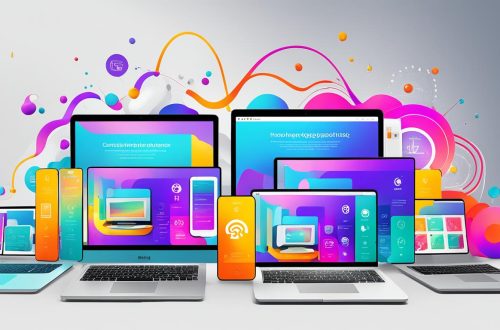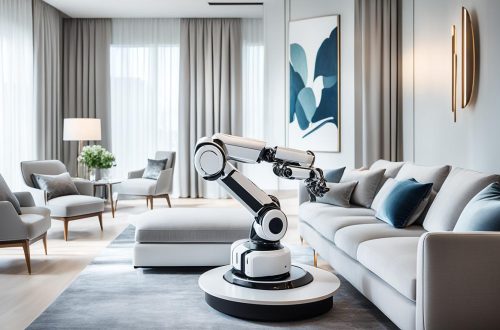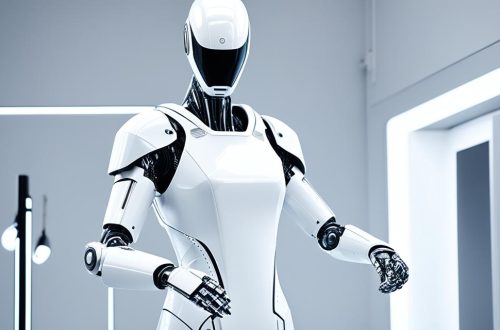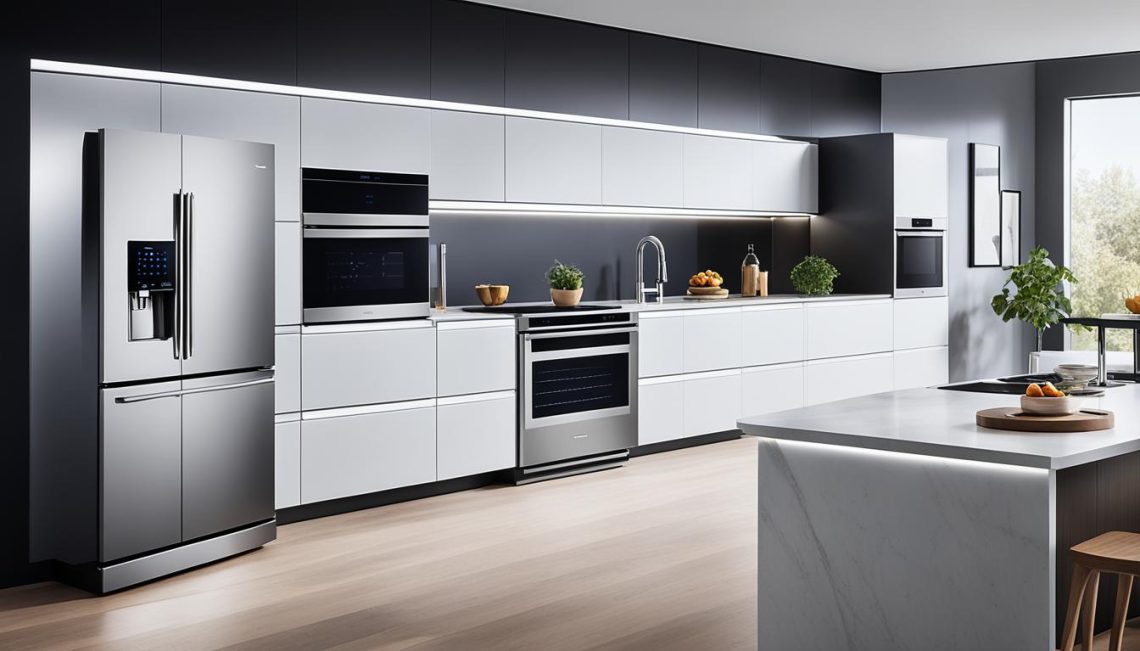
The Zenith of Zest: Infusing Everyday Luxury with the Spice of Smart Devices
Welcome to the world of luxury infused with the cutting-edge technology of smart devices. In the era of the Internet of Things (IoT), our everyday lives are being transformed, bringing convenience, efficiency, and a touch of sophistication to our homes. With the seamless integration of smart devices, we now have the power to elevate our living experience to new heights, creating a truly luxurious lifestyle.
Key Takeaways:
- The Internet of Things (IoT) has revolutionized our homes, providing convenience and bringing luxury to our daily lives.
- Smart home devices enhance our home experience with features like automated lighting, temperature control, and voice assistants.
- IoT applications extend beyond our homes, impacting areas such as healthcare, energy efficiency, and the development of smart cities.
- Connectivity and security are crucial in maximizing the benefits of IoT, ensuring seamless communication and protection against cyber threats.
- The future of IoT holds incredible potential, with advancements in technology and increased adoption leading to endless possibilities.
What is the Internet of Things (IoT)?
The Internet of Things (IoT) is a revolutionary concept that has brought about a paradigm shift in the way we live and interact with technology. It refers to the network of interconnected devices, objects, and systems that communicate with each other and with us through the internet. These devices are embedded with sensors, software, and connectivity capabilities, allowing them to collect and exchange data.
IoT technology encompasses a diverse range of devices, from everyday household items like thermostats and lightbulbs to industrial machinery and vehicles. These devices interact with each other and with their users, creating an ecosystem of interconnectedness and automation.
The key driving force behind IoT is the seamless exchange of data. Connected devices can gather information about their environment, analyze it, and make intelligent decisions based on the insights gained. This enables increased automation, efficiency, and convenience in various aspects of our lives.
“IoT technology has the potential to transform industries, revolutionize our homes, and create innovative solutions to complex challenges.”
The applications of IoT are extensive and diverse. In healthcare, IoT-enabled medical devices can monitor patients remotely and transmit real-time data to healthcare professionals, improving diagnosis and patient outcomes. In the transportation sector, IoT technology enables smart traffic management systems, optimizing routes and reducing congestion. The possibilities are endless.
Furthermore, IoT solutions are not limited to specific industries or sectors. They have the potential to enhance our overall quality of life, making our homes smarter, more efficient, and more secure. From smart thermostats that adjust the temperature based on our preferences to voice-activated virtual assistants that can control our entire home, IoT technology is transforming the way we interact with our living spaces.
The growth of IoT is driven by the increasing availability of high-speed internet, advancements in wireless connectivity, and the decreasing cost of sensors and processing power. As these technologies continue to evolve, IoT will become an integral part of our daily lives, seamlessly integrating technology into our routines and enhancing our overall experience.
Benefits of IoT Technology:
- Automation: IoT devices can automate various tasks, saving time and effort.
- Efficiency: Smart devices connected through IoT can optimize energy usage and improve resource allocation.
- Convenience: IoT technology enables remote control and monitoring of devices, providing convenience and peace of mind.
- Data-driven insights: The data collected by IoT devices can provide valuable insights for businesses, leading to informed decision-making.
- Improved safety and security: IoT-enabled security systems can detect intrusions, monitor for potential hazards, and alert users in real-time.
As we continue to embrace IoT technology, its potential to transform various industries and improve our quality of life becomes increasingly evident. From homes to healthcare, IoT solutions are set to reshape the world as we know it.
Smart Home Devices and Automation
In today’s digitally connected world, smart home devices have become an integral part of our lives. These connected devices offer a convenient and efficient way to manage and automate various aspects of our homes. From controlling the temperature and lighting to monitoring security and managing appliances, smart home automation has revolutionized the way we interact with our living spaces.
One of the key advantages of smart home devices is their ability to provide convenience. With the touch of a button or a simple voice command, you can control multiple devices and systems in your home. For example, a smart thermostat allows you to adjust the temperature remotely, ensuring a comfortable environment when you arrive home. Similarly, smart lighting systems enable you to create different ambiance settings and control them effortlessly using your smartphone or voice-controlled assistant.
Smart home devices also offer incredible energy efficiency. By automating lighting, heating, and cooling systems, you can optimize energy usage and reduce wastage. For instance, smart thermostats can learn your preferences and adjust the temperature based on occupancy, leading to significant energy savings over time. Additionally, smart plugs and power strips allow you to conveniently turn off appliances and electronics when they are not in use, further reducing energy consumption.
Enhanced security is another crucial benefit of smart home devices. With the integration of security cameras, smart locks, and motion sensors, you can monitor and protect your home remotely. Receive real-time alerts on your smartphone if any suspicious activity is detected, allowing you to take immediate action. Whether you are at work or on vacation, smart home security systems provide peace of mind by keeping you connected and in control of your home’s safety.
To illustrate the multitude of smart home devices and automation options available, take a look at the following table:
| Device | Description |
|---|---|
| Smart Thermostat | Control and optimize your home’s temperature settings for energy efficiency and comfort. |
| Smart Lighting System | Adjust and automate lighting settings to create the perfect ambiance and save energy. |
| Security Cameras | Monitor and protect your home with high-definition cameras and real-time alerts. |
| Voice-Controlled Assistant | Interact with your smart home devices using voice commands for a seamless and hands-free experience. |
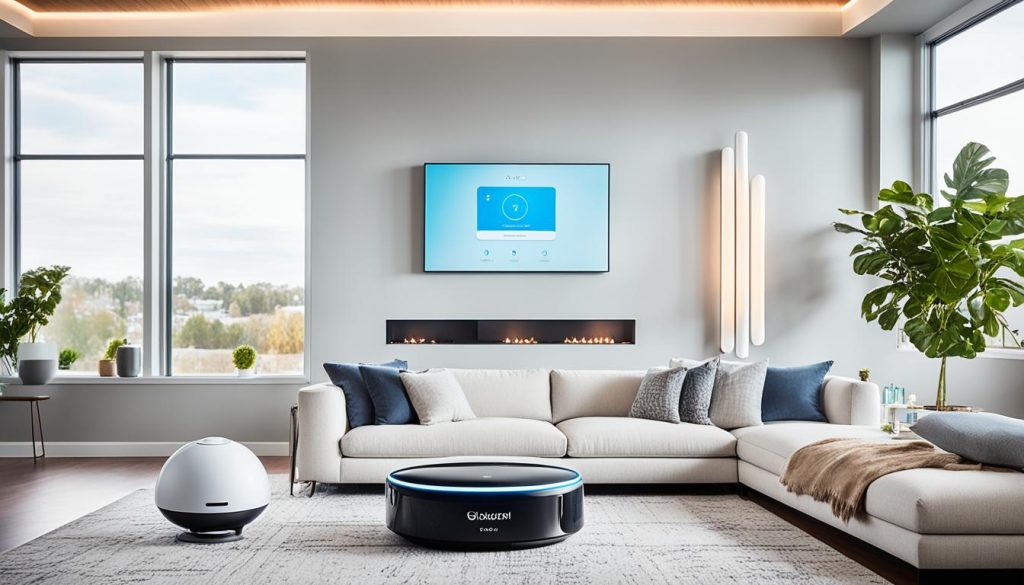
IoT Applications in Everyday Life
The Internet of Things (IoT) has revolutionized our everyday lives, bringing forth a multitude of applications and technologies that seamlessly integrate into our routines. From wearable fitness trackers to smart appliances and personal assistants, IoT devices have become an integral part of our daily lives, enhancing convenience and efficiency.
Imagine a morning where your smart alarm clock wakes you up gently, adjusting the room’s lighting and temperature to create an optimal waking environment. As you start your day, your wearable fitness tracker seamlessly syncs with your smartphone, providing real-time data on your health and activity levels. While preparing breakfast, your smart kitchen appliances automatically adjust cooking times and temperatures based on recipe recommendations, ensuring a perfect meal every time. And before leaving for work, you simply tell your voice-controlled personal assistant to lock the doors, adjust the thermostat, and set the security system—all from the convenience of your smartphone.
Such is the power of IoT devices and technologies, providing us with the ability to monitor our health, automate tasks, and create personalized experiences tailored to our preferences. Let’s explore some of the common IoT applications in everyday life:
1. Wearable Fitness Trackers
Wearable fitness trackers, such as fitness bands and smartwatches, have become increasingly popular for tracking physical activity, sleep patterns, heart rate, and more. These devices use built-in sensors to collect data and provide valuable insights into our health and well-being.
2. Smart Home Appliances
Smart home appliances, such as thermostats, lighting systems, and kitchen appliances, offer convenience and energy efficiency. With IoT connectivity, these devices can be controlled remotely, allowing us to adjust settings and monitor energy consumption even when we’re away.
3. Personal Assistants
Voice-controlled personal assistants, like Amazon Echo and Google Home, have transformed the way we interact with our homes. These devices can perform various tasks, such as playing music, setting reminders, answering questions, and even controlling other IoT devices in our homes.
4. Connected Cars
IoT technologies have extended into the automotive industry, enabling connected cars that provide enhanced safety, navigation assistance, and entertainment options. From integrated GPS systems to real-time traffic updates, IoT-enabled cars offer a seamless driving experience.
5. Smart Health Devices
IoT has brought significant advancements to the healthcare industry, with smart health devices that monitor vital signs, track medication schedules, and enable remote patient monitoring. These devices empower individuals to take control of their health and enable healthcare providers to deliver better care.
6. Smart Security Systems
IoT-based security systems provide advanced monitoring and control capabilities for our homes. With connected cameras, motion sensors, and smart locks, we can monitor our homes remotely, receive real-time notifications, and ensure the safety of our loved ones.
7. Intelligent Energy Management
IoT technologies have also enabled intelligent energy management systems. Smart thermostats, lighting controls, and energy monitoring devices allow us to optimize energy usage, reduce costs, and contribute to a more sustainable environment.
| IoT Applications | Benefits |
|---|---|
| Wearable Fitness Trackers | Monitor health and activity levels |
| Smart Home Appliances | Convenience and energy efficiency |
| Personal Assistants | Seamless control of IoT devices |
| Connected Cars | Enhanced safety and navigation |
| Smart Health Devices | Remote patient monitoring and personalized care |
| Smart Security Systems | Real-time monitoring and control |
| Intelligent Energy Management | Optimized energy usage and cost savings |
As technology continues to advance, the possibilities for IoT applications in our everyday lives are limitless. These technologies have seamlessly integrated into our routines, making our lives more connected, convenient, and personalized. From improving our health and well-being to enhancing the efficiency of our homes, IoT is transforming the way we live.
IoT and Home Security
The integration of IoT into home security systems has revolutionized the way we protect our homes. With IoT sensors and connectivity, homeowners can now experience real-time monitoring, remote access, and enhanced security features. These technologies not only enhance the safety of our homes but also provide peace of mind and convenience.
IoT security systems utilize a network of connected sensors strategically placed throughout the house. These sensors detect intrusions, fire, or water leaks, and promptly send alerts to homeowners’ smartphones or other smart devices. With this instant notification, homeowners can take immediate action and contact authorities if needed, even when they are away.
“The integration of IoT into home security systems has added an extra layer of protection to our homes. With real-time monitoring and instant alerts, homeowners can always stay connected to their homes and have peace of mind.”
These IoT security systems also enable remote access, allowing homeowners to monitor and control their security settings from anywhere in the world. Through smartphone apps or web interfaces, homeowners can arm or disarm the alarm system, view live video feeds from security cameras, or even lock and unlock doors remotely.
Furthermore, IoT connectivity enables intelligent security systems that can learn and adapt to homeowners’ habits. These systems can detect patterns of activity and adjust security settings accordingly. For example, if the system detects that a door is often left unlocked at a specific time, it can automatically send a reminder notification to the homeowner’s device.
With the advancement of IoT technologies, home security systems have become more sophisticated and effective. They offer a higher level of protection, convenience, and customization, tailored to the specific needs of homeowners. Whether it’s the ability to monitor and control security settings remotely or the peace of mind that comes from real-time notifications, IoT has transformed home security into a smart and connected experience.
Benefits of IoT in Home Security:
- Real-time monitoring: IoT sensors provide instant notifications and alerts for intrusions and other security breaches.
- Remote access: Homeowners can control security settings, view live video feeds, and lock or unlock doors from anywhere through smartphone apps or web interfaces.
- Intelligent security systems: IoT connectivity enables systems that adapt to homeowners’ habits and adjust security settings accordingly.
- Peace of mind: With constant connectivity and instant alerts, homeowners can have peace of mind knowing their homes are secure, even when they are away.
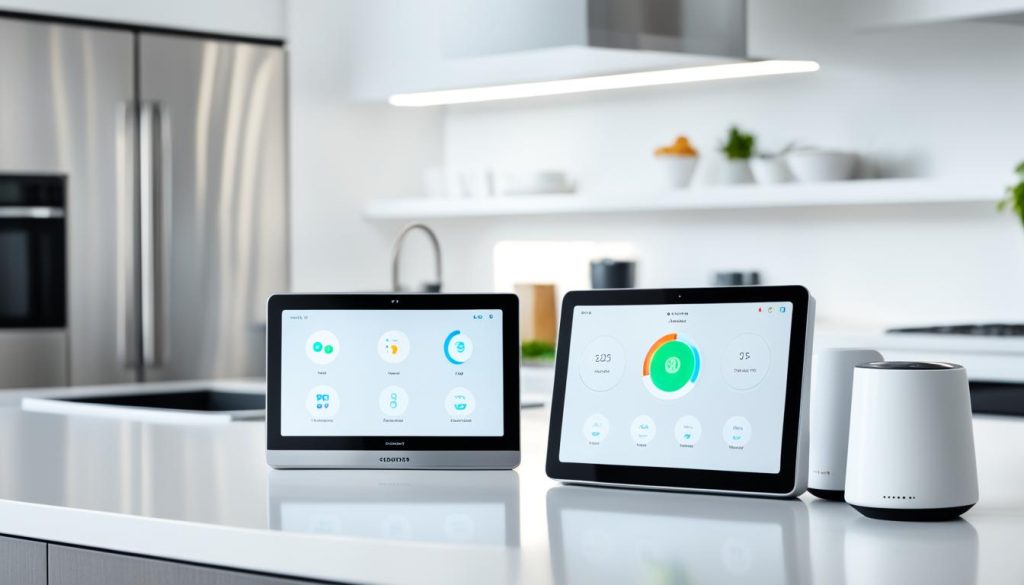
IoT and Energy Efficiency
In today’s rapidly evolving world, the Internet of Things (IoT) has emerged as a game-changer, revolutionizing the way we manage energy consumption in our homes. With IoT platforms and connectivity, we now have the power to optimize our energy usage, promote sustainability, and embrace energy-efficient solutions.
Thanks to smart devices, our homes can become intelligent ecosystems, monitoring and controlling energy consumption with precision. These devices leverage IoT connectivity to collect real-time data, allowing us to adjust settings based on occupancy, time of day, and individual preferences. By integrating renewable energy sources such as solar panels or wind turbines, we can further enhance energy efficiency and reduce our carbon footprint.
“Connecting smart devices through IoT platforms has unlocked a new era of energy management and optimization.” – Sarah Green, Sustainability Expert
IoT platforms provide us with comprehensive insights into our energy usage patterns, helping us identify inefficiencies and make informed decisions to reduce wastage. By analyzing data from various smart devices, such as smart thermostats, lighting systems, and appliances, we can pinpoint energy-hungry areas and implement measures to address them.
Additionally, IoT connectivity allows us to control our energy consumption remotely. Imagine being able to monitor your home’s energy usage and adjust settings on the go. Whether you’re at work, on vacation, or simply lounging on your couch, you can ensure that your energy consumption is optimized and aligned with your needs and preferences.
Promoting a Sustainable Future
The integration of IoT and energy efficiency goes beyond personal benefits. It plays a crucial role in promoting a sustainable future for our planet. By leveraging IoT platforms and connectivity, we can collectively reduce our energy demand, lessen our dependence on fossil fuels, and contribute to a greener world.
Smart devices connected to IoT networks have the potential to create a domino effect, inspiring wider adoption of energy-efficient practices. As more homes embrace IoT technology and prioritize energy efficiency, the cumulative impact will ripple across communities and even entire cities.
With IoT and energy efficiency working hand in hand, we can unlock a multitude of possibilities. By taking advantage of the advancements in IoT platforms and connectivity, we can create a smarter, more sustainable world, where energy consumption is optimized, costs are reduced, and our planet thrives.
IoT and Energy Efficiency: A Data-Driven Approach
Data is at the heart of every IoT-powered energy efficiency initiative. As smart devices gather information about our energy consumption patterns, this data can be analyzed to drive further optimizations and inform decision-making processes.
To illustrate the power of data-driven energy efficiency, let’s take a look at a hypothetical example:
| Smart Device | Energy Consumption (kWh) |
|---|---|
| Smart Thermostat | 100 |
| Smart Lighting System | 50 |
| Smart Appliances | 75 |
| Total Energy Consumption | 225 |
In this scenario, the data collected from various smart devices highlights the significant contribution of each device to the overall energy consumption. Armed with this information, homeowners can make informed decisions on energy-saving strategies. For instance, they might decide to adjust the thermostat settings, switch to energy-efficient light bulbs, or upgrade to more energy-efficient appliances.
By monitoring and analyzing data, homeowners can continually refine their energy usage and optimize efficiency. This data-driven approach empowers individuals to take control of their energy consumption, reduce costs, and contribute to a more sustainable future.
Embracing IoT platforms, connectivity, and energy-efficient solutions allows us to take an active role in shaping a sustainable future. By working together, we can leverage the transformative power of IoT to optimize our homes’ energy usage, reduce our environmental impact, and embark on a path towards a more energy-efficient and eco-conscious world.
The Future of IoT and Smart Devices
As we look ahead, the future of IoT development and smart home devices holds immense potential. With advanced technologies and increasing adoption, these connected devices are set to revolutionize various aspects of our lives. The integration of 5G networks, artificial intelligence (AI), and machine learning (ML) will fuel further advancements, enhancing the capabilities and functionalities of IoT devices.
Imagine a world where our homes seamlessly adapt to our needs and preferences, optimizing our daily routines. Smart home devices, powered by IoT technologies, will play a central role in this transformation. From voice-controlled assistants to energy-efficient appliances and intuitive home automation systems, these devices will enable us to create personalized living spaces that enhance our comfort, convenience, and overall well-being.
“The ability of smart devices to communicate and cooperate with each other will revolutionize the way we live. This interconnectedness will lead to unprecedented automation and personalized experiences, making our lives easier and more enjoyable.” – Mark Adams, IoT expert
Advancements in IoT Technologies
IoT technologies will continue to evolve, propelling the development of innovative devices and applications. With 5G networks becoming widespread, the connectivity and data transfer speeds will reach new heights. This will enable seamless communication and real-time interactions between devices, unlocking a multitude of possibilities.
Artificial intelligence and machine learning will further enhance the capabilities of IoT devices. These technologies will enable devices to learn from user behavior, adapt to their preferences, and anticipate their needs. From intelligent personal assistants that tailor their responses based on user interaction to sophisticated predictive maintenance systems that optimize device performance, AI and ML will drive the evolution of IoT devices to new heights.
The Expanding Universe of Smart Home Devices
The world of smart home devices is expanding rapidly, with countless new innovations on the horizon. From smart thermostats that optimize energy consumption to intelligent lighting systems that create ambiance with a simple voice command, these devices bring convenience, efficiency, and luxury to our fingertips.
Take, for example, the emergence of smart refrigerators. Equipped with sensors and connectivity, these refrigerators can track food inventory, suggest recipes based on available ingredients, and even notify users when it’s time to restock. These devices not only streamline our daily routines but also contribute to reducing food waste and promoting sustainable living practices.
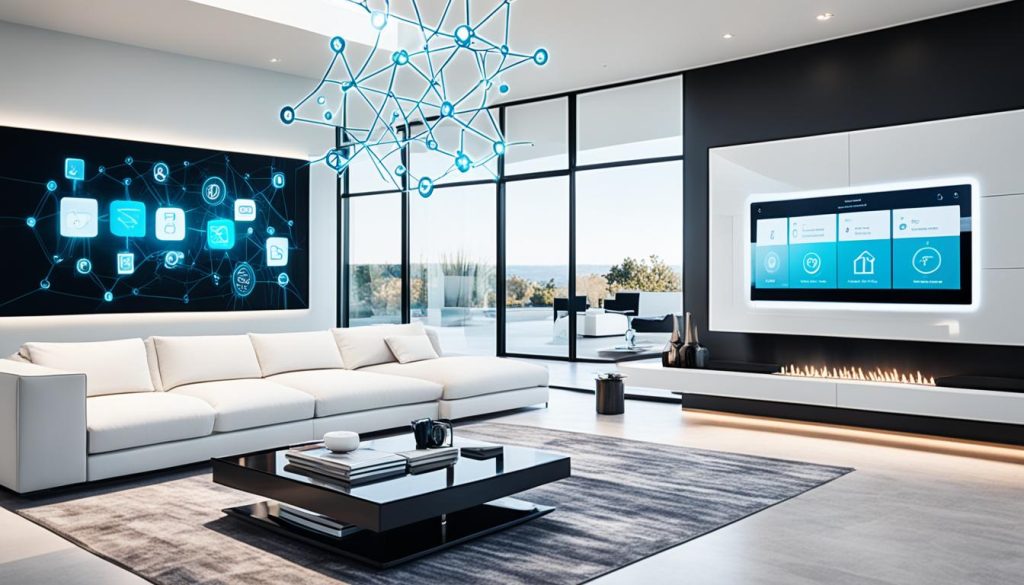
The Promise of Personalized Experiences
As IoT devices become increasingly interconnected, they will offer us personalized experiences like never before. Imagine waking up to a home that adjusts lighting and temperature to match your preferences, prepares your preferred cup of coffee, and syncs with your morning routine seamlessly.
With smart devices integrated throughout our homes, we can curate personalized environments for different activities. Whether it’s an energizing atmosphere for a workout, a calming ambiance for relaxation, or an entertainment setup for a movie night, IoT technologies allow us to customize our surroundings with ease.
The Journey Ahead
The future of IoT and smart home devices is a fascinating one. With ongoing advancements, we can expect a world where our homes continuously learn from us, adapt to our needs, and support our lifestyles. As IoT technologies continue to evolve and mature, we have an exciting journey ahead, filled with endless possibilities and a more connected, convenient, and luxurious way of living.
The Importance of IoT Connectivity
For the success of IoT, strong and reliable connectivity is imperative. IoT connectivity refers to the network that connects IoT devices, allowing them to communicate and exchange data. Robust connectivity solutions, such as high-speed internet and wireless networks, play a crucial role in enabling seamless communication between devices and facilitating efficient data exchange.
IoT connectivity forms the backbone of IoT solutions, powering the smooth operation of smart devices and unlocking their full potential. Without reliable connectivity, the benefits of IoT technologies may be limited or even rendered ineffective.
One of the key advantages of IoT connectivity is its ability to enable real-time data transmission. Connected devices can exchange information instantaneously, paving the way for timely and accurate decision-making. For example, in a smart home environment, IoT connectivity allows the synchronization of devices such as thermostats, lighting systems, and security cameras, creating an interconnected ecosystem that enhances convenience and energy efficiency.
Furthermore, IoT connectivity enables remote access and control of devices, offering unparalleled convenience and flexibility. Through a smartphone or other compatible devices, users can remotely monitor and manage their IoT devices from anywhere, at any time. This enhances convenience, saves time, and provides peace of mind, knowing that one can always stay connected to their smart devices.
When it comes to industrial IoT applications, reliable connectivity becomes even more critical. Manufacturing processes rely on the smooth operation of interconnected devices, with data being constantly collected, analyzed, and acted upon. A disruption in connectivity can result in significant downtime, leading to operational inefficiencies and financial losses.
IoT connectivity solutions ensure that various devices and components within an industrial setup can seamlessly communicate, enabling efficient production and supply chain management.
Moreover, IoT connectivity plays a vital role in the healthcare industry. It enables the transmission of vital health data from medical devices to healthcare professionals, facilitating remote monitoring and timely interventions. With continuous connectivity, patients can enjoy personalized care, reducing the need for frequent hospital visits and improving overall healthcare outcomes.
In summary, IoT connectivity is the lifeline of IoT solutions. It provides the necessary infrastructure for connected devices to communicate, exchange data, and operate seamlessly. With reliable connectivity, IoT technologies can deliver their full potential, transforming various aspects of our lives, from smart homes to industries and healthcare.
Benefits of IoT Connectivity:
- Real-time data transmission
- Remote access and control
- Enhanced convenience and flexibility
- Increased operational efficiency
- Improved healthcare outcomes
Investing in robust IoT connectivity solutions is crucial for organizations and individuals looking to harness the power of IoT technologies and unlock the benefits they offer.
| Benefits of IoT Connectivity | Use Cases |
|---|---|
| Real-time data transmission | Industrial IoT monitoring and control systems |
| Remote access and control | Smart home automation |
| Enhanced convenience and flexibility | Healthcare remote monitoring |
| Increased operational efficiency | Smart city infrastructure management |
| Improved healthcare outcomes | Telemedicine and remote patient monitoring |
Ensuring IoT Security
As the Internet of Things (IoT) becomes more prevalent in our daily lives, ensuring the security of connected devices is of utmost importance. With the increasing number of IoT devices and their interconnectivity, protecting them from cyber threats, data breaches, and unauthorized access has become crucial.
Strong encryption and authentication protocols are essential measures in safeguarding IoT devices and the sensitive information they collect. Encryption ensures that data transmitted between devices is secure and cannot be deciphered by unauthorized individuals. Authentication protocols verify the identity of users and devices, preventing unauthorized access and ensuring that only authorized individuals can interact with the IoT system.
Regular software updates play a vital role in enhancing IoT security. These updates often include security patches that address vulnerabilities and protect against new threats. By keeping IoT devices up to date with the latest software versions, users can ensure that their devices are equipped with the most robust security features.
It is also important for users to be aware of the potential risks associated with connected devices and take necessary precautions. This includes using strong, unique passwords for each IoT device, regularly monitoring device activity, and being cautious about granting permissions and access rights.
“The security of IoT devices is critical as they are often connected to sensitive data and can be used as entry points to breach larger networks.” – Security Expert
Furthermore, IoT solutions providers should prioritize security in the design and development of their products. Implementing security measures such as data encryption, secure device provisioning, and regular security audits can help ensure that IoT devices are resilient to cyber threats.
In conclusion, IoT security is paramount in the age of interconnected devices. By implementing strong encryption, authentication protocols, and regular software updates, users can protect their connected devices and the valuable data they collect. Additionally, being proactive in taking necessary precautions and choosing reliable IoT solutions providers will contribute to a safer and more secure IoT ecosystem.
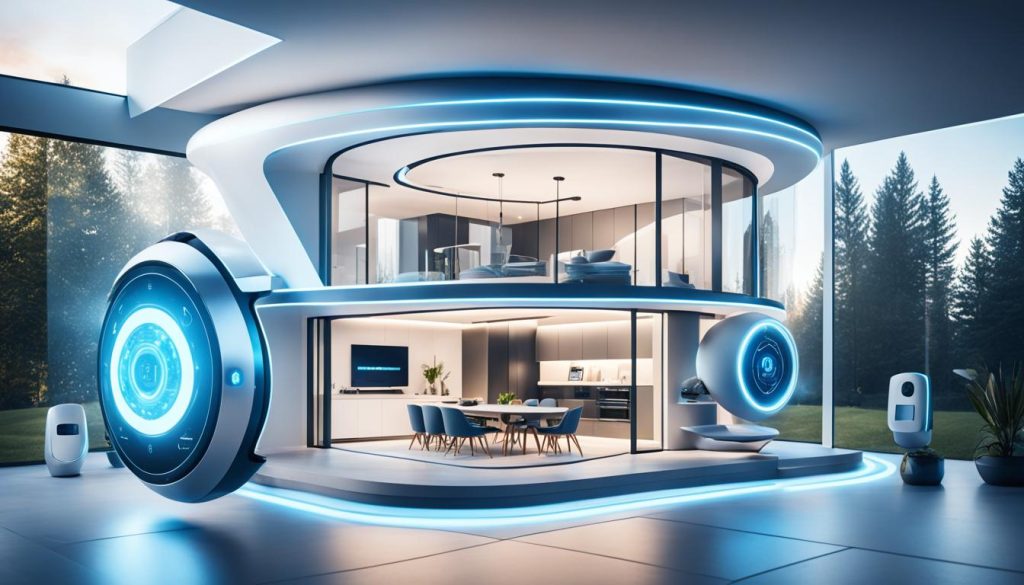
The Role of IoT in Healthcare
The integration of Internet of Things (IoT) technology in the healthcare industry has brought about revolutionary changes, transforming the way we receive medical care and improving patient outcomes. With the help of connected medical devices and remote monitoring, healthcare IoT has enabled remote patient monitoring, telemedicine, and personalized care.
Medical devices connected to IoT networks provide healthcare professionals with real-time data, enabling them to make more accurate diagnoses and proactive interventions. By continuously monitoring patients’ vital signs, IoT-powered medical devices can detect any deviations from the norm and alert healthcare providers, allowing for timely interventions and preventing potential medical emergencies.
“The integration of IoT in healthcare has the potential to revolutionize patient care by bringing healthcare services to the patient’s doorstep, regardless of geographical location.”
The Benefits of Remote Monitoring
Remote monitoring, made possible by healthcare IoT, has opened up new opportunities for patients to receive medical attention from the comfort of their homes. This is especially beneficial for patients with chronic conditions or those living in remote areas with limited access to healthcare facilities.
Remote monitoring devices, such as wearable sensors and smart implants, collect and transmit real-time data on patients’ health parameters, such as heart rate, blood pressure, and blood glucose levels. This data is securely transmitted to healthcare providers, who can closely monitor patients’ conditions, adjust medication or treatment plans, and provide timely guidance and support.
Telemedicine: Bridging the Gap
Telemedicine, another application of healthcare IoT, enables virtual consultations and remote diagnosis through video calls or secure messaging platforms. Patients can connect with healthcare professionals, discuss their symptoms, and receive medical advice without the need for in-person visits.
This has proven particularly useful during times of crisis, such as the ongoing COVID-19 pandemic, where social distancing measures and overwhelmed healthcare systems have made traditional in-person consultations difficult. Telemedicine not only ensures the continuity of care but also minimizes the risk of exposure to infectious diseases.
Personalized Care and Improved Outcomes
IoT in healthcare facilitates the delivery of personalized care, tailored to individual patients’ needs and preferences. With the help of connected devices and IoT platforms, healthcare providers can gather comprehensive data on patients’ health and lifestyle, allowing for more targeted interventions and treatment plans.
By leveraging healthcare IoT, medical professionals can gain insights into patients’ activity levels, sleep patterns, and medication adherence. This enables them to make informed decisions, provide personalized recommendations, and empower patients to take an active role in managing their health.
The Future of Healthcare IoT
The role of IoT in healthcare is poised to expand further in the future. As technology continues to advance, we can expect more sophisticated and interconnected medical devices, improved data analytics, and enhanced communication networks.
The integration of artificial intelligence (AI) and machine learning with healthcare IoT will enable predictive analytics, early disease detection, and more precise treatment recommendations. This will not only improve patient outcomes but also enhance the overall efficiency and effectiveness of healthcare delivery.
As healthcare IoT continues to evolve, it holds the potential to democratize access to quality healthcare, bridge the gap between patients and providers, and empower individuals to take charge of their well-being.
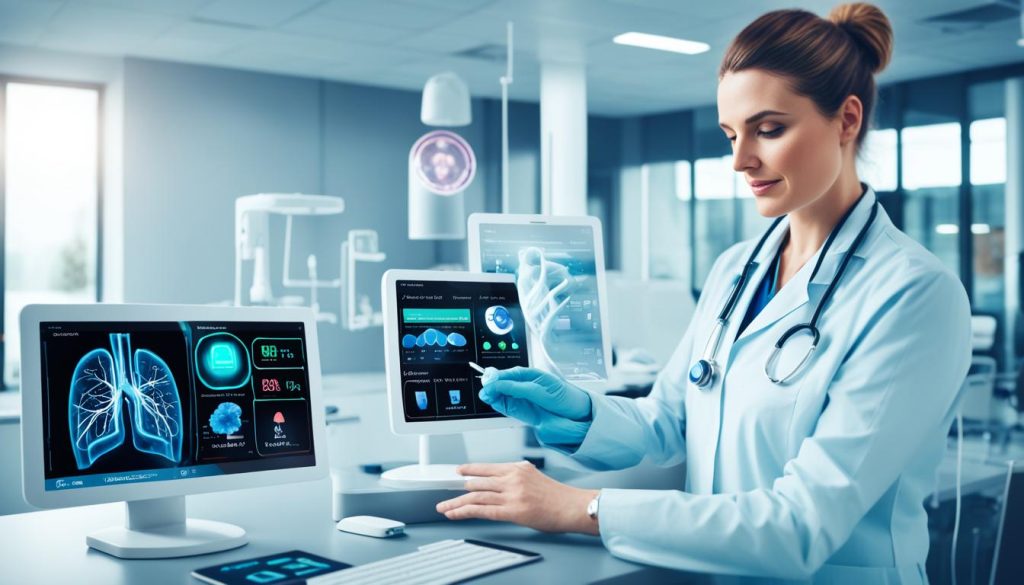
To learn more about the other applications of IoT in different sectors, continue reading our article.
Smart Cities and IoT
The concept of smart cities is revolutionizing urban infrastructure and services by leveraging the power of IoT technologies. By interconnecting various systems and optimizing their operations, cities can enhance efficiency, sustainability, and the overall quality of life for their residents.
The Advantages of IoT in Smart Cities
IoT technologies enable smart cities to develop innovative solutions across multiple sectors, addressing key challenges and creating a more connected and sustainable environment. Let’s explore some of the key areas where IoT is transforming urban landscapes:
- Smart transportation systems: IoT enables real-time monitoring of traffic conditions and optimized routing, reducing congestion and improving the efficiency of public transportation. Commuters can access accurate information about bus and train schedules, helping them plan their journeys more effectively.
- Efficient energy management: IoT sensors and smart grid technology enable efficient energy distribution and consumption monitoring, reducing waste and promoting sustainability. Cities can intelligently manage street lighting, optimize power usage in buildings, and integrate renewable energy sources.
- Waste management: IoT devices equipped with sensors can monitor waste levels in bins, optimizing collection routes and reducing unnecessary pickups. This not only improves efficiency but also contributes to a cleaner and healthier environment.
- Improved public safety: IoT-powered surveillance cameras, smart streetlights, and emergency response systems enhance public safety in smart cities. Real-time monitoring and analytics enable swift responses to incidents, improving overall security.
Through the integration of IoT technologies, smart cities are moving towards a more interconnected and intelligent future. The seamless flow of information between devices, infrastructure, and people allows for efficient resource allocation, reduced environmental impact, and improved livability.
An Example of IoT in Smart Cities
“IoT plays a crucial role in transforming Barcelona into a smart city. The city implemented a comprehensive system of IoT devices and sensors to optimize urban services and improve the quality of life for its citizens. This includes environmental monitoring, smart lighting, waste management, and smart parking solutions. By harnessing the power of IoT, Barcelona has become a global leader in smart city innovation.”
By learning from successful implementations like Barcelona’s, cities around the world can adapt and implement IoT solutions tailored to their unique needs, creating more efficient, sustainable, and livable urban environments.
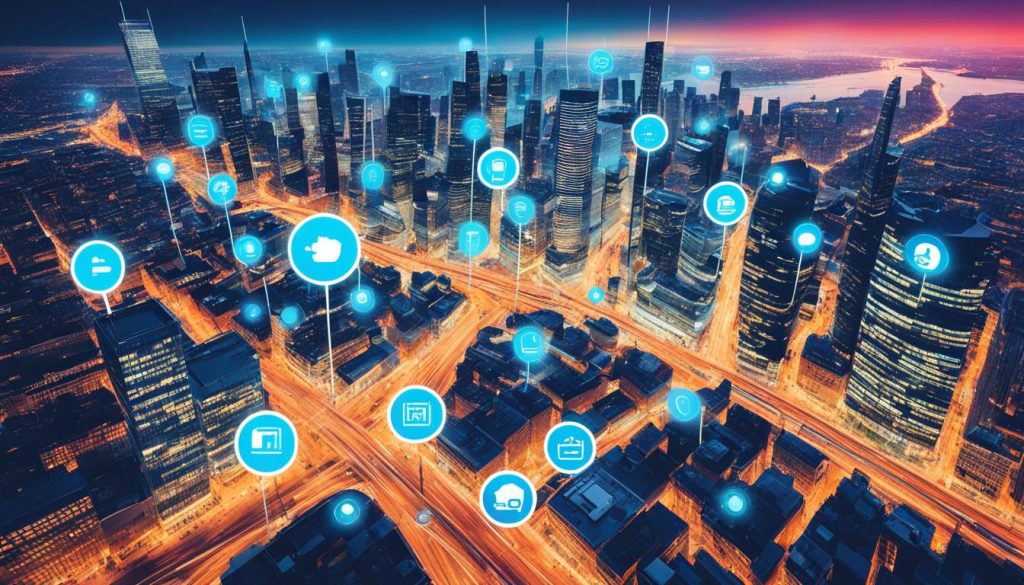
The Future of Smart Cities and IoT
The potential of IoT in the context of smart cities is vast and ever-evolving. As technology advances, cities will be able to integrate more systems and services, enabling even greater connectivity and automation. The future may include autonomous vehicles, personalized services based on real-time data, and enhanced citizen engagement through smart city platforms.
| Benefits of IoT in Smart Cities | Challenges of IoT in Smart Cities |
|---|---|
| Improved efficiency and cost savings | Privacy and data security concerns |
| Enhanced sustainability and reduced environmental impact | Managing a complex ecosystem of interconnected devices |
| Improved quality of life for residents | Ensuring equitable access to IoT services |
As the world embraces the potential of smart cities and IoT technologies, we can expect to see continuous advancements and innovations that shape the future of urban living. By harnessing the power of interconnected devices, cities have the opportunity to create a more sustainable, efficient, and inclusive future for all.
Conclusion
The integration of IoT and smart devices has revolutionized our lives, offering a new level of convenience and luxury. From transforming our homes into smart environments to enhancing healthcare and building smart cities, IoT has opened up endless possibilities for us to live a more connected and convenient lifestyle.
By embracing IoT technologies, we can experience the seamless integration of smart devices that elevate our living experience. Smart homes empower us to control and automate various aspects, from lighting and temperature to security and entertainment, creating a truly personalized and luxurious living environment.
Furthermore, IoT is transforming healthcare by enabling remote monitoring, telemedicine, and personalized care. With medical devices connected to IoT networks, healthcare professionals can access real-time data, leading to more accurate diagnoses and proactive interventions. This integration is improving patient outcomes and revolutionizing how we receive medical care.
Smart cities are also benefiting from IoT, optimizing urban infrastructure and services for efficiency and sustainability. By leveraging IoT technologies, cities can improve transportation systems, energy management, waste management, and public safety, enhancing the quality of life for residents and creating more sustainable urban environments.
Overall, the integration of IoT and smart devices offers us a luxurious lifestyle, where convenience, personalization, and efficiency come together seamlessly. By embracing these technologies, we can transform our daily lives and pave the way for a future that is more connected, convenient, and luxurious.
FAQ
What is the Internet of Things (IoT)?
How do smart home devices enhance our living experience?
What are the applications of IoT in our everyday lives?
How does IoT enhance home security?
How does IoT contribute to energy efficiency?
What does the future hold for IoT and smart devices?
Why is IoT connectivity important?
How can we ensure the security of IoT devices?
What role does IoT play in healthcare?
How does IoT contribute to building smart cities?
Source Links
- http://theherald.online/tag/quincy-police-department/?FF_articleid=api/v1/contents/8490/content?FFESID=8490&page=featuredetails&FF_uid=food-99999-108283-8490
- https://www.connollycove.com/the-souks-spice-markets-of-the-middle-east/
- https://www.grubhub.com/restaurant/west-ridge-wine–spirits-5435-w-ridge-rd-spencerport/7928080


